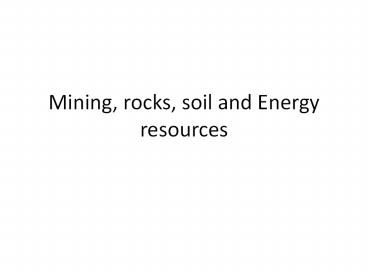Mining, rocks, soil and Energy resources - PowerPoint PPT Presentation
Title:
Mining, rocks, soil and Energy resources
Description:
Mining, rocks, soil and Energy resources Mining Why do we mine? To get ore Ore: A rock containing a mineral A places with a concentration of ore is referred to as a ... – PowerPoint PPT presentation
Number of Views:156
Avg rating:3.0/5.0
Title: Mining, rocks, soil and Energy resources
1
Mining, rocks, soil and Energy resources
2
Mining
- Why do we mine? To get ore
- Ore A rock containing a mineral
- A places with a concentration of ore is referred
to as a deposit
3
Possible uses of some minerals mined in Quebec
- Gold jewellery, trade, electronic equipment
- Copper pipes for plumbing, electrical wire
- Zinc galvanized steel (to prevent corrosion)
- Nickel stainless steel manufacture, coins,
magnets - Iron steel manufacture
4
Rocks
- Types of rocks
- Igneous (formed when magma cools and solidifies)
- Sedimentary (formed by the accumulation/compaction
of debris) - Metamorphic (formed when igneous or sedimentary
rocks have been transformed by heat and/or
pressure)
5
Uses of rocks
- Granite ornamental stone
- Sandstone building materials
- Marble interior design, decorative objects
6
Soil
- Naturally occurring, loose covering on the
earth's surface. - Made up of broken rock particles that have been
altered by chemical and environmental conditions.
- Soil can be altered by interactions between the
lithosphere, hydrosphere, atmosphere, and the
biosphere.
7
Soil Horizons (Layers)
- A specific layer in the soil which measures
parallel to the soil surface and possesses
physical characteristics which differ from the
layers above and beneath.
8
(No Transcript)
9
Layers
- O- composed mainly of humus, organic layers of
plant and animal residue - A- mixture of humus and minerals soluble in
water, support plant life (Topsoil) - B- composed of small particles of minerals, dense
(tree roots get their nutrients here) - C- degradation of rocks, unconsolidated soil
parent material - R- partially-weathered bedrock at the base of the
soil profile. (starting point of soil formation)
10
Permafrost
- Permafrost is ground whose temperature has been 0
degrees Celsius for at least two years. - 50 of the land in Canada is covered in
permafrost.
11
Energy resources
- Other than minerals the lithosphere also contains
much of the worlds energy resources
12
Fossil fuels
- Fossil fuels result from the transformation of
organic residue. These energy sources consists of
oil, natural gas and coal. - Non-renewable source of energy.
13
Fossil fuels
- When fossil fuels burn they emit thermal energy.
- Often the thermal energy is converted into
electrical energy or mechanical energy ( i.e. to
make an engine work) - Combustion also gives off by-products
- CO2 (greenhouse gase)
- NOx and SO2 are responsible for acid rain
- - CH4 (21x more powerful than CO2 as a
greenhouse gas)
14
Uranium
- Uranium is used as a source for nuclear energy.
- Nuclear energy the energy stored in the bonds
between the particles in the nucleus of an atom. - Quebec has on nuclear plant, the Gentilly-2
Nuclear Generating Station.
15
Geothermics
- Geothermal energy is the energy that comes from
the internal heat of the Earth. - It is a renewable source of energy.
16
In class work
- P. 215
- Questions 10 to 19































